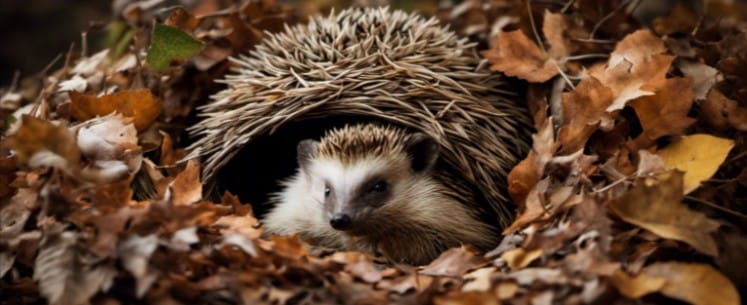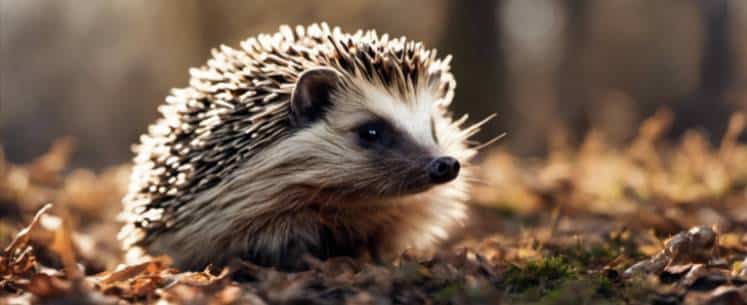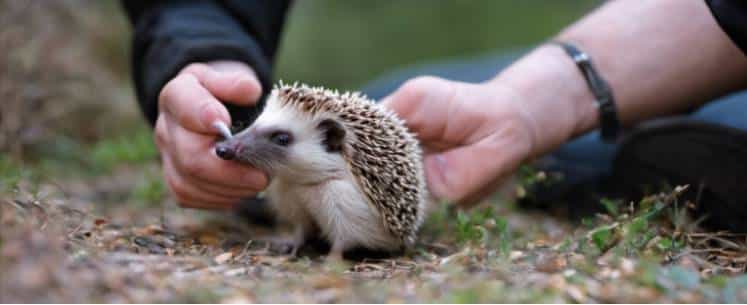As hedgehog enthusiasts, we often wonder about their winter habits. Do they simply sleep in their burrows or hibernate like other animals? Well, the answer is that hedgehogs do indeed hibernate.
However, the location of their hibernation depends on their natural habitat and the climate they live in.
In this article, we will explore the world of hedgehog hibernation and discover where these tiny animals go during winter. From the different types of locations where they hibernate to the reasons why they hibernate, we will cover it all.
So, if you’re curious about these adorable creatures and their winter habits, keep reading!
What is hibernation?

Hibernation is a state of dormancy that many mammals enter during winter months. It is a survival strategy that allows animals to conserve energy when food is scarce and temperatures are low.
During hibernation, animals like hedgehogs lower their body temperature and slow down their metabolism, reducing their energy requirements.
Hibernating animals typically spend long periods of time in a den or burrow, where they can remain safe and insulated from the cold weather.
True hibernators, like hedgehogs, experience a significant decrease in heart rate and breathing, which helps them conserve energy while avoiding freezing temperatures and food shortages outside their den.
In preparation for hibernation, animals must store enough fat reserves to sustain themselves through the winter months. Hedgehogs will often eat heavily prior to entering their den so that they have all the resources necessary for a successful hibernation season.
Once inside their den, these animals remain dormant until the warmer weather arrives in springtime, when they emerge from their winter slumber.
Should you let your hedgehog hibernate?

Hedgehogs should only be allowed to hibernate if they are in a safe and warm environment. As pet owners, it is our responsibility to ensure that our hedgehogs have the necessary conditions to hibernate successfully. Here are some important factors to consider:
- Food. Hedgehogs need to have enough fat reserves to survive hibernation. Make sure they are well-fed before entering hibernation.
- Welfare. Ensure that your hedgehog is in good health and free from any injuries or illnesses before allowing them to hibernate.
- Disturbance. Avoid disturbing your hedgehog while they are hibernating as it can cause them to wake up and use up valuable energy reserves.
- Death. Hibernation can be dangerous for hedgehogs. If they do not have enough fat reserves, they may not survive the winter.
- Water. Hedgehogs do not need water while hibernating as they are in a state of suspended animation.
- Health. Monitor your hedgehog’s health and weight throughout the hibernation period.
- Supplementary feeding. Do not feed your hedgehog during hibernation as they will not be able to digest food properly.
- Leftover food. Remove any leftover food from your hedgehog’s enclosure before they enter hibernation to prevent it from rotting and attracting pests.
Remember, if you are unsure about the conditions or your hedgehog’s health, it is best to avoid allowing them to enter hibernation.
Read also: Can Hedgehogs Eat Fish? (Everything You Need to Know!)
Do hedgehogs hibernate in captivity?

Hedgehogs are known to hibernate in the wild, but whether or not they hibernate in captivity depends on various factors.
Pet hedgehogs kept indoors with a constant temperature and a steady food supply are less likely to hibernate. However, if they are kept in an outdoor enclosure or a room with fluctuating temperatures, they may enter into a hibernation-like state known as torpor.
This can be dangerous for hedgehogs as they may not have enough fat reserves to survive a long period of hibernation.
To prevent unintentional hibernation or torpor, hedgehog owners should monitor their pet’s behavior and environment. Providing a consistent temperature and regular access to food can help prevent hibernation in pet hedgehogs.
It is important to note that if a pet hedgehog does enter into hibernation or torpor, it should be handled with extreme care and taken to a veterinarian immediately.
Why do hedgehogs hibernate?

Hedgehogs hibernate during winter months to survive the cold weather and food shortages. This adaptation allows them to conserve energy, decrease their body temperature, and slow down metabolism.
During hibernation, hedgehogs nestle into a den or burrow, where they remain safe and insulated from the cold temperatures outside. This is crucial as it allows them to preserve their fat stores and avoid starvation during the cold months.
How long do hedgehogs hibernate?

Hedgehogs usually hibernate for around 4 to 5 months, from November to March or April. However, the exact length of hibernation can vary depending on the temperature and food availability.
During hibernation, hedgehogs enter a state of reduced metabolic activity, which helps them conserve energy during the winter months when food is scarce.
They may wake up periodically to eat, drink, and move around, but for the most part, they remain in a state of torpor until the weather warms up.
Providing hedgehogs with a safe and suitable place to hibernate is essential, as disturbances during hibernation can be fatal for them.
Read also: Do Hedgehogs Eat Snakes? (Explained for Beginners)
How are pet hedgehogs different from wild hedgehogs in terms of winter habits?

Pet hedgehogs and wild hedgehogs have some distinct differences when it comes to their winter habits. Pet hedgehogs typically do not need to hibernate during the winter months in order to survive.
They are able to maintain a relatively stable body temperature in warm indoor environments, so they can remain active throughout the year.
Wild hedgehogs, on the other hand, must enter a state of hibernation in order to cope with colder temperatures and a lack of food sources during the winter months.
Overall, pet hedgehogs are much better equipped to handle cold winter temperatures than their wild counterparts due to their ability to regulate their own body temperature and access to ample food supplies year-round.
Therefore, it’s important that pet owners take extra precautions, such as providing additional bedding materials or specialized cages designed for hibernation purposes when necessary.
Do hedgehogs hibernate together?

Hedgehogs are generally solitary animals and do not hibernate together in groups. However, it’s not uncommon for hedgehogs to share a hibernation site if they happen to find a suitable location with enough space and resources.
In some cases, hedgehogs may even hibernate in the same nest or burrow, although they will usually keep their distance from each other to avoid conflict.
Providing hedgehogs with a safe and suitable place to hibernate is important, as disturbances during hibernation can be fatal for them. If you come across a hibernating hedgehog, it’s best to leave it alone and avoid disturbing it.
When do hedgehogs come out of hibernation?

Hedgehogs usually come out of hibernation in March or April, when the weather starts to warm up and food becomes more readily available.
However, the exact timing can vary depending on the temperature and other environmental factors. Hedgehogs may wake up periodically during hibernation to drink, eat, and move around, but they will usually return to their hibernation site until it’s time to emerge for the spring.
When hedgehogs come out of hibernation, they will be hungry and thirsty, so it’s crucial to provide them with food and water. You can put out a shallow dish of water and some cat or dog food to help them recover from hibernation.
How to tell if a hedgehog is hibernating?

When hedgehogs are hibernating, they enter a state of torpor, which means that their body temperature drops and their metabolic rate slows down. They will be in a deep sleep and will not be active during this time. Here are some signs that a hedgehog may be hibernating:
- No movement. If you come across a hedgehog that is not moving, it may be hibernating. Hedgehogs in hibernation will not respond to external stimuli and will not move around.
- Cold to the touch. Hedgehogs in hibernation will have a lower body temperature and may feel cold to the touch.
- Shallow breathing. Hedgehogs in hibernation will have a slower breathing rate, and their breathing may be shallow.
- Curled up. Hedgehogs in hibernation will be curled up into a tight ball, with their spines exposed.
- No response to touch. If you touch a hedgehog in hibernation, it will not respond or move.
It’s vital to leave hedgehogs in hibernation alone, as disturbing them can be harmful and may cause them to wake up prematurely. If you are concerned about a hedgehog that you think maybe hibernating, it’s best to contact a local wildlife rescue organization for advice.
Do hedgehogs live underground?

Hedgehogs do not live underground, but they do use underground burrows as a place to hibernate or to escape from predators. Hedgehogs are nocturnal animals, and they spend most of their waking hours foraging for food, exploring their surroundings, and socializing with other hedgehogs. During the day, hedgehogs rest in a nest or under a hedge, log, or other sheltered area.
In the winter months, hedgehogs may use underground burrows to hibernate, but they do not live in burrows year-round. Instead, they prefer to live in a variety of habitats, including gardens, parks, woodlands, and hedgerows.
They are adaptable animals and can thrive in both urban and rural environments.
Hedgehog hibernation facts

Hedgehogs are known for their hibernation habits during the winter months, where they enter a state of reduced metabolic activity to conserve energy. Here are some interesting facts about hedgehog hibernation:
- Hedgehogs hibernate during the winter months. Hedgehogs are known for hibernating during the winter months when the temperature drops below 15°C (59°F). They usually start hibernating in November and can remain in hibernation until March or April.
- They prepare for hibernation by building up fat reserves. Before hibernation, hedgehogs build up fat reserves by eating as much food as possible. They can gain up to 50% of their body weight in fat.
- Their heart rate and body temperature drop. During hibernation, hedgehogs’ heart rate drops from around 190 beats per minute to just 20 beats per minute. Their body temperature also drops from around 35°C (95°F) to just a few degrees above freezing.
- They wake up periodically. Hedgehogs don’t hibernate continuously throughout the winter. They wake up periodically to eat, drink, and move around. These periods of activity are called “arousals”.
- Hedgehogs can die during hibernation. If hedgehogs are disturbed during hibernation or if their hibernation conditions are not suitable, they can die. Providing hedgehogs with a safe and suitable place to hibernate is important.
- They may hibernate in different locations each year. Hedgehogs don’t always hibernate in the same location each year. They may move to a different location if their hibernation conditions are not suitable or if they feel threatened.
Summary
- Hedgehogs hibernate in a variety of places depending on their natural habitat and climate.
- Hedgehogs need a safe and warm place to hibernate to conserve energy during the winter when food is scarce.
- It is not recommended to let pet hedgehogs hibernate unless they are in a safe and warm environment, and providing a consistent temperature and regular access to food can help prevent hibernation.
Conclusion
Hedgehogs are uniquely adapted to survive the cold winter months by hibernating in suitable dens and nests. Wild hedgehogs typically enter a state of hibernation to conserve energy during this time, while pet hedgehogs can usually remain active in warm indoor environments.
Want to learn more about hedgehogs?
Ready to boost your knowledge to the next level? If so, check out the articles below:
- How Fast Are Hedgehogs? (Checked and Explained)
- Hedgehogs Poop Color: Everything You Need to Know!
- How Long Can a Hedgehog Be Left Alone? (Read This First!)





